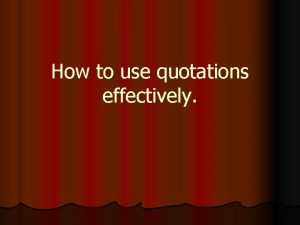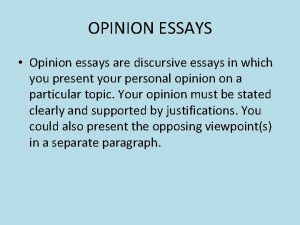Inserting Quotes into Essays Using Quotes Effectively The












- Slides: 12

Inserting Quotes into Essays Using Quotes Effectively

The 5 Basic Steps: • • • Know your point of view Identify your quote Introduce your quote Cite your quote Discuss your quote

Using Quotes: Step One 1. Introduce your quotations. A quotation should never suddenly appear out of nowhere. Some kind of information about the quotation is needed. A. Suggested Techniques: Name the author, give his credentials, name the source, give a summary.

• For example: a. But John Jones disagrees with this point, saying, "Such a product would not sell. " • b. In an article in Time Fred Jackson writes that frogs vary in the degree of shyness they exhibit: "The poisonous dart frogs seem to be especially weary. "

Introducing Quotes… • Use some variety in introducing quotations. One way of doing this is by varying the verbs you choose to use directly before the quote: • A. Pick the quotation verb which seems in each case to fit your purpose most exactly. For example: In this essay Green tells us, "Hope increases courage. "

Introducing Quotes… Note: The particular verb you choose helps orient your reader toward your opinion of the statement (“connotation”). • Example: The boy is lazy. The girl was fat. ~ "Jones says" is neutral ~"Jones informs us" is positive ~ "Jones alleges" is somewhat negative.

Other ways to Introduce a Quote… • • • says writes observes notes remarks adds declares informs us alleges • • • claims states comments thinks affirms asserts explains argues suggests

Using Quotes: Step Two 2. Citing Quotes in the Text After you have introduced your quote, it’s time to give the author credit. “You are being perverse. ” (Sophocles 19)

Getting to the Point: What do YOU Think? • 3. Discuss your quotations. Do not quote someone and then leave the words hanging as if they were self explanatory. Explain: • What does the quote mean? • How does it help establish the point you are making? How does it fit in with your thesis and with the ideas you are presenting? • What is your interpretation or opinion of it?

Getting to the Point: What do YOU Think? • Remember: Quotations are like examples! • They support or illustrate your own points. They are not substitutes for your ideas and they do not stand by themselves!

Commenting on a Quote… • It is often useful to apply some interpretive phrasing after a quotation, to show the reader that the you are explaining the quotation and that it supports your argument: • Thus … • This statement illustrates… • Clearly, then, … • It can be concluded from this that …

Any Questions?
 Analyzing quotes
Analyzing quotes Quotes in essays examples
Quotes in essays examples The art of using language effectively and persuasively
The art of using language effectively and persuasively The art of using language effectively
The art of using language effectively How to effectively use quotes etecreview
How to effectively use quotes etecreview Hình ảnh bộ gõ cơ thể búng tay
Hình ảnh bộ gõ cơ thể búng tay Ng-html
Ng-html Bổ thể
Bổ thể Tỉ lệ cơ thể trẻ em
Tỉ lệ cơ thể trẻ em Chó sói
Chó sói Tư thế worm breton
Tư thế worm breton Chúa yêu trần thế alleluia
Chúa yêu trần thế alleluia Các môn thể thao bắt đầu bằng tiếng chạy
Các môn thể thao bắt đầu bằng tiếng chạy























